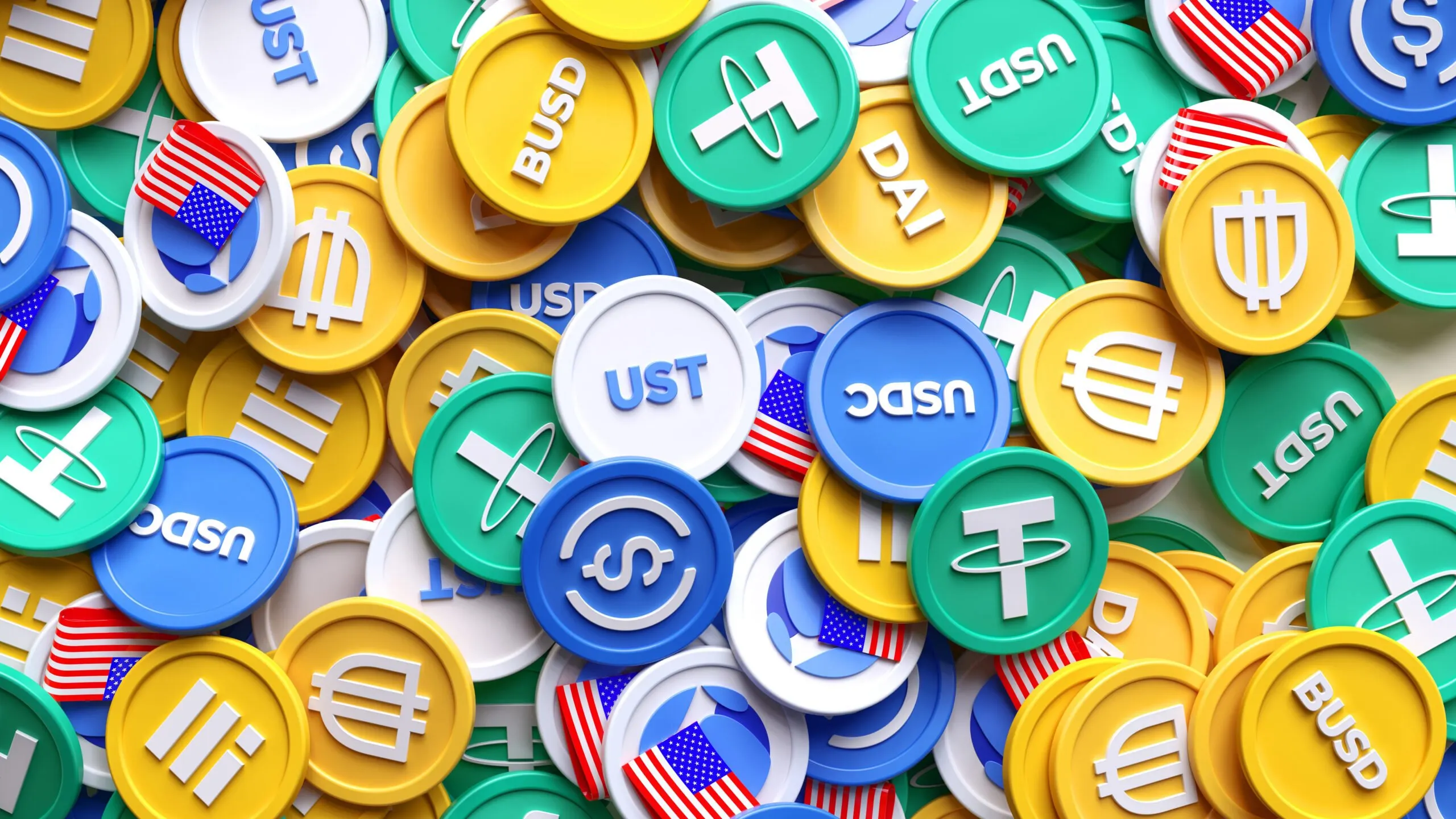Another key finding is that stablecoins are overwhelmingly dollarized. Today, 99% of stablecoins rely on the US dollar. This number has actually gone UP since we first ran the numbers in our 2020 whitepaper (https://t.co/dYqPW4y1Wx) pic.twitter.com/qx5nYKs479
— nic carter (@nic__carter) September 12, 2024
Coin Prices
BTC
$90,340.00
-1.98%ETH
$3,117.56
-1.62%XRP
$2.06
-1.91%BNB
$886.76
-2.60%USDC
$0.9998
0.00%SOL
$132.90
-3.85%STETH
$3,117.23
-1.61%TRX
$0.280932
-2.06%DOGE
$0.140587
-1.84%ADA
$0.425989
-2.31%FIGR_HELOC
$1.03
1.03%WBT
$60.77
-1.23%WSTETH
$3,808.27
-1.58%BCH
$572.72
-4.79%WBTC
$90,183.00
-1.96%WBETH
$3,383.85
-1.65%LINK
$13.81
-2.87%USDS
$0.999762
0.01%BSC-USD
$0.999785
-0.02%LEO
$9.66
-0.47%WETH
$3,118.70
-1.82%WEETH
$3,377.12
-1.81%XLM
$0.239751
-1.88%HYPE
$27.92
-8.93%XMR
$373.50
-1.52%ZEC
$411.50
8.85%USDE
$0.998631
-0.19%CBBTC
$90,373.00
-1.83%LTC
$83.41
-0.54%SUI
$1.61
-1.89%AVAX
$13.68
-0.85%HBAR
$0.133076
-2.74%SHIB
$0.00000855
1.05%USDT0
$0.999941
-0.04%SUSDS
$1.08
0.18%WLFI
$0.149191
-1.28%TON
$1.63
-2.49%CRO
$0.103414
-1.74%PYUSD
$0.999306
-0.03%MNT
$1.11
-2.09%SUSDE
$1.21
0.02%DOT
$2.11
-2.35%UNI
$5.47
-4.65%TAO
$303.78
0.28%AAVE
$189.32
-2.90%USD1
$0.998811
-0.03%CC
$0.073123
7.69%BGB
$3.56
-0.52%OKB
$111.37
-0.77%M
$1.32
6.69%NEAR
$1.72
-3.69%XAUT
$4,191.43
-0.59%USDF
$0.998926
-0.11%ENA
$0.269718
-3.94%ETC
$13.34
-1.71%BUIDL
$1.00
0.00%ASTER
$0.940476
-3.81%PEPE
$0.0000046
-2.60%WETH
$3,118.11
-1.67%JITOSOL
$165.68
-4.03%PI
$0.218459
-1.05%ICP
$3.34
-5.64%RAIN
$0.00757976
-1.07%PUMP
$0.00297152
-5.43%SOL
$132.87
-4.00%JLP
$4.66
-2.06%SYRUPUSDC
$1.14
0.06%ONDO
$0.475276
-0.19%HTX
$0.00000161
-2.27%PAXG
$4,202.03
-0.39%WLD
$0.594645
0.87%USDG
$0.99976
-0.02%KAS
$0.050765
-4.66%KCS
$10.25
-1.73%BFUSD
$0.999095
-0.01%HASH
$0.02520034
-11.35%RETH
$3,588.27
-1.73%APT
$1.77
-0.27%SYRUPUSDT
$1.11
-0.07%USYC
$1.11
-0.00%POL
$0.122961
-2.21%RLUSD
$0.999667
-0.01%USDC
$0.999802
-0.02%QNT
$86.48
-5.33%SKY
$0.05442
1.25%GT
$10.33
-0.08%ARB
$0.214163
-0.30%WBNB
$887.08
-2.63%ALGO
$0.132288
-2.21%BNSOL
$144.46
-4.12%TRUMP
$5.67
-0.77%RSETH
$3,303.29
-1.11%FIL
$1.48
-2.55%ATOM
$2.22
-1.91%VET
$0.01242933
-2.34%FBTC
$90,455.00
-2.34%USDTB
$0.999857
-0.01%FLR
$0.01296902
-2.07%LSETH
$3,336.20
-0.66%SOLVBTC
$90,144.00
-2.11%LBTC
$90,311.00
-2.20%NEXO
$0.961869
-2.24%XDC
$0.04827384
-2.93%USTB
$10.92
0.01%RENDER
$1.64
-0.42%SEI
$0.130684
-3.27%FDUSD
$0.998301
0.02%BONK
$0.00000937
-1.39%OUSG
$113.56
0.02%CAKE
$2.29
-1.16%EZETH
$3,321.14
-1.86%KHYPE
$28.07
-9.22%JAAA
$1.016
0.04%METH
$3,366.10
-1.60%WBTC
$90,338.00
-1.68%PENGU
$0.01143402
-2.70%CLBTC
$90,614.00
-1.74%JUP
$0.221166
-2.58%IP
$2.09
-5.29%USDY
$1.10
-0.36%USDC.E
$0.999799
0.00%MORPHO
$1.20
-2.49%JUPSOL
$153.54
-3.85%USDAI
$1.00
0.02%DAI
$0.999931
-0.01%OSETH
$3,191.27
-2.05%FET
$0.237882
-3.58%DASH
$48.36
1.44%WETH
$3,117.52
-1.93%BDX
$0.086194
0.09%OP
$0.315368
-3.40%SPX
$0.636122
-7.82%AERO
$0.65161
-5.31%ULTIMA
$5,749.61
6.00%INJ
$5.56
-4.54%CRV
$0.388263
-2.39%TBTC
$90,048.00
-2.25%VIRTUAL
$0.840289
-3.33%USD0
$0.998151
-0.27%STX
$0.298839
-2.09%MYX
$2.83
-3.19%LDO
$0.597799
-1.26%WETH
$3,119.05
-1.81%XTZ
$0.483399
-0.93%STRK
$0.107217
-6.08%USDD
$0.999882
0.00%ETHFI
$0.823333
-1.49%TEL
$0.00523513
-5.70%GTETH
$3,118.01
-1.78%TUSD
$0.997196
-0.02%TIA
$0.578268
-2.14%CGETH.HASHKEY
$2,460.42
0.00%GRT
$0.04528815
-3.67%FLOKI
$0.00004958
3.87%MSOL
$178.73
-3.06%ETHX
$3,353.16
-1.81%EUTBL
$1.22
-0.07%USDT
$0.995227
-0.89%KAIA
$0.077717
-2.05%2Z
$0.130504
-5.54%LIQUIDETH
$3,318.24
-0.41%GHO
$0.999798
-0.11%STEAKUSDC
$1.11
0.01%ENS
$11.21
-1.78%IOTA
$0.102503
-2.13%AB
$0.00465786
-12.44%SWETH
$3,432.77
-0.04%TWT
$0.980898
-4.38%USDB
$1.005
0.43%BTT
$0.00000041
-1.28%BSV
$20.15
-1.55%CBETH
$3,466.95
-1.53%SUN
$0.02080742
-3.07%SBTC
$90,455.00
-1.62%BAT
$0.264876
2.29%ENZOBTC
$90,454.00
0.00%PYTH
$0.067646
-4.90%DCR
$22.62
5.83%WIF
$0.383333
-1.59%JST
$0.03864169
-0.38%FARTCOIN
$0.37534
-7.49%PENDLE
$2.29
-6.93%SAD
$0.378224
-30.50%CFX
$0.072722
-2.34%OHM
$22.79
-0.66%BTC.B
$90,353.00
-1.91%SAND
$0.141102
-2.11%NFT
$0.00000037
-0.37%DOGE
$0.140665
-1.61%S
$0.093596
-3.19%MERL
$0.338083
-3.60%EETH
$3,119.53
-0.54%HNT
$1.90
-4.35%FLOW
$0.211758
-2.82%EURC
$1.16
-0.11%SAVAX
$16.88
-1.32%JASMY
$0.00689322
-1.24%THETA
$0.34044
-2.01%CHZ
$0.03343323
5.41%GALA
$0.00720343
-2.65%GNO
$125.93
-2.43%USX
$0.999205
-0.02%WEETH
$3,372.44
-1.41%LUNC
$0.00005831
20.03%VSN
$0.093374
-0.21%KAU
$133.90
-1.60%MWC
$27.99
8.12%XPL
$0.160113
-8.11%BUSD
$0.99826
-0.71%SYRUP
$0.267409
-3.47%FRXETH
$3,077.00
-1.71%RAY
$1.13
-2.82%COMP
$30.97
-1.18%CUSD
$0.999618
0.06%JTRSY
$1.088
0.03%UBTC
$90,427.00
-1.76%CMETH
$3,370.96
-1.22%BORG
$0.297569
-3.90%WETH
$3,122.45
-1.54%MANA
$0.15091
-2.87%STABLE
$0.01603928
-40.05%NEO
$4.08
-1.85%A
$0.178363
-2.56%MON
$0.0263908
-9.21%ZBCN
$0.00296163
4.04%ZRO
$1.40
1.14%ASBNB
$940.39
-2.40%FRAX
$0.993407
-0.09%ZK
$0.03242845
-3.69%WHYPE
$27.91
-8.94%GTBTC
$90,417.00
-1.97%FDIT
$1.00
0.00%AR
$4.01
-3.03%FF
$0.111829
-1.51%CRVUSD
$1.00
-0.16%WETH
$3,117.70
-1.83%SENA
$0.270205
-2.56%WAVAX
$13.69
-1.10%B
$0.252101
5.04%UDS
$2.45
3.64%FTN
$0.577102
0.62%FLUID
$3.23
-2.22%WAL
$0.161262
-0.94%1INCH
$0.175699
-2.98%APEPE
$0.00000114
-8.16%REAL
$0.079121
-2.84%RUNE
$0.671944
-1.42%CHEEMS
$0.00000116
-7.69%
